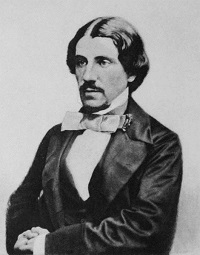
The Rating of Poets Х The Rating of Poems
William Allingham. Biography

William Allingham (19 March 1824 Ц 18 November 1889) was an Irish poet, diarist and editor. He wrote several volumes of lyric verse, and his poem 'The Faeries' was much anthologised; but he is better known for his posthumously published Diary, in which he records his lively encounters with Tennyson, Carlyle and other writers and artists. His wife, Helen Allingham, was a well-known watercolourist and illustrator.
William Allingham was born on 19 March 1824 in the small town of Ballyshannon, County Donegal, Ireland, and was the son of the manager of a local bank who was of English descent. His younger brothers and sisters were Catherine (b. 1826), John (b. 1827), Jane (b. 1829), Edward (b. 1831; who lived only a few months) and a still-born brother (b. 1833). During his childhood his parents moved twice within the town, where the boy enjoyed the country sights and gardens, learned to paint and listened to his mother's piano-playing. When he was nine, his mother died.
He obtained a post in the custom-house of his native town, and held several similar posts in Ireland and England until 1870. During this period were published his Poems (1850; which included his well-known poem, 'The Fairies') and "Day and Night Songs" (1855; illustrated by Dante Gabriel Rossetti and others). (Rossetti's "Letters to Allingham" (1854Ц1870), edited by Dr. Birkbeck Hill, were published in 1897.) Laurence Bloomfield in Ireland, his most ambitious, though not his most successful work, a narrative poem illustrative of Irish social questions, appeared in 1864. He also edited "The Ballad Book" for the "Golden Treasury" series in 1864, and "Fifty Modern Poems" in 1865.
In April 1870 Allingham retired from the customs service, moved to London and became sub-editor of "Fraser's Magazine", eventually becoming editor in succession to James Froude in June 1874 Ц a post he would hold till 1879. On 22 August 1874 he married the illustrator, Helen Paterson, who was twenty-four years younger than he. His wife gave up her work as an illustrator and would become well known under her married name as a water-colour painter. At first the couple lived in London, at 12 Trafalgar Square, Chelsea, near Allingham's friend, Thomas Carlyle, and it was there that they had their first two children Ц Gerald Carlyle (b. 1875 November) and Eva Margaret (b. 1877 February). In 1877 appeared Allingham's "Songs, Poems and Ballads". In 1881, after the death of Carlyle, the Allinghams moved to Sandhills near Witley in Surrey, where their third child, Henry William, was born in 1882. At this period Allingham published "Evil May Day" (1883), "Blackberries" (1884) and "Irish Songs and Poems" (1887).
In 1888, because of William's declining health, they moved back to the capital, to the heights of Hampstead village. But in 1889, on 18 November, William died at Hampstead. According to his wishes he was cremated. His ashes are interred at St. Anne's church in his native Ballyshannon.
Posthumously Allingham's Varieties in Prose was published in 1893. William Allingham A Diary, edited by Mrs Helen Allingham and D. Radford, was published in 1907. It contains Allingham's reminiscences of Alfred Tennyson, Thomas Carlyle and other writers and artists.
William Allingham's Poems:
30940 Views
English Poetry. E-mail eng-poetry.ru@yandex.ru